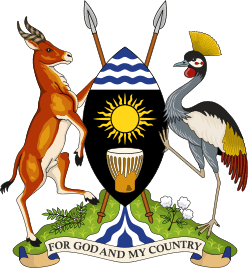Ugandan Bush War
| Ugandan Bush War (aka Luwero War) | |||||||
|---|---|---|---|---|---|---|---|
| |||||||
| Belligerents | |||||||
|
|
Supported by: | ||||||
| Commanders and leaders | |||||||
|
Tito Okello David Oyite-Ojok Smith Opon Acak Bazilio Olara-Okello |
Yoweri Museveni Salim Saleh Steven Kashaka Joram Muguma Pecos Kuteesa Fred Rwigyema | ||||||
| Casualties and losses | |||||||
| 100,000[3][4]–500,000[5][6] | |||||||
The Ugandan Bush War (also known as the Luwero War, the Ugandan civil war or the Resistance War) refers to the guerrilla war waged between 1981 and 1986 in Uganda by the National Resistance Army (NRA) under the leadership of Yoweri Museveni against the government of Milton Obote, and later that of Tito Okello.
The war
Museveni and his supporters retreated to the southwest of the country and formed the Popular Resistance Army (PRA). The PRA later merged with former president Lule's group, the Uganda Freedom Fighters (UFF), to create the National Resistance Army (NRA) and its political wing, the National Resistance Movement (NRM).[7] Concurrently, two other rebel groups, the Uganda National Rescue Front (UNRF) and Former Uganda National Army (FUNA), formed in West Nile from the remnants of Amin's supporters and fought the UNLA in West Nile.[8] Paul Kagame and Rwandan exiles in Uganda (who later formed the Rwandan Patriotic Front), fought in this war for Museveni's NRA. Kagame, trained in Tanzania as a spy, became Museveni's counter-intelligence chief. [9][10]
NRA's bush war began with an attack on an army installation in the central Mubende District on 6 February 1981. Museveni, who had guerrilla war experience with the Mozambican Liberation Front (FRELIMO) in Mozambique, and his own Front for National Salvation (FRONASA) formed in Tanzania to fight Idi Amin, campaigned in rural areas hostile to Obote's government, especially central and western Buganda and in the regions of Ankole and Bunyoro in western Uganda.[11]
Most of the battles were conducted by small mobile units which were designated as "A" Coy commanded by Steven Kashaka, "B" Coy under Joram Mugume, and "C" Coy under Pecos Kuteesa. The commander of these forces was Fred Rwigyema, assisted by Salim Saleh, Museveni's brother. There were three small zonal forces – Lutta Unit in the areas of Kapeeka, Kabalega Unit in the areas near Kiwoko, and Nkrumah Unit in the areas of Ssingo.[12]
Human rights abuses
Obote's UNLA forces retorted in an effort to retaliate against the NRA, resulting in loss of civilian life in the affected areas. UNLA soldiers consisted of many ethnic Acholi and Lango, and although the Acholi and Lango themselves were survivors of Amin's genocidal purges in northern Uganda, the soldiers conducted actions reminiscent of Amin's. In early 1983, to eliminate rural support for Museveni's guerrillas, the area of the then Luweero District, including present-day Kiboga, Kyankwanzi, Nakaseke, among other, was targeted for a massive population removal affecting almost 750,000 people. The resultant refugee camps were subject to military control, and in many cases human rights abuses. Many civilians outside the camps, in what came to be known as the "Luweero triangle", were blamed for being guerrilla sympathizers and were treated accordingly. By July 1985, Amnesty International estimated that the Obote regime had been responsible for more than 300,000 civilian deaths across Uganda.
NRA, likewise, committed atrocities, including the use of land mines specifically against civilians. Child soldiers were widely used by the NRA as guerrillas, and also subsequently when NRA became the regular army.[13]
References
- ↑ Gberie, Lansana (2005). A Dirty War in West Africa: The RUF and the Destruction of Sierra Leone. London: Hurst & Company. ISBN 1-85065-742-4.
- ↑ Ssemujju Ibrahim Nganda (30 July 2009). "WHO FOUGHT? Chihandae supplied 16 of the first 27 NRA guns". The Observer. Retrieved 31 May 2016.
- ↑ Encarta, Microsoft Encarta '95.
- ↑ Eckhardt, William, in World Military and Social Expenditures 1987-88 (12th ed., 1987) by Ruth Leger Sivard.
- ↑ Henry Wasswa, “Uganda's first prime minister, and two-time president, dead at 80,” Associated Press, October 10, 2005
- ↑ "B&J": Jacob Bercovitch and Richard Jackson, International Conflict : A Chronological Encyclopedia of Conflicts and Their Management 1945-1995 (1997)
- ↑ "A Country Study: The Ten-Point Program", Library of Congress Country Studies
- ↑ "Peace and conflict in northern Uganda 2002-06 (2010)". c-r.org.
- ↑ http://www.observer.ug/index.php?option=com_content&task=view&id=4535&Itemid=59
- ↑ "Africandictator.org". africandictator.org.
- ↑ "A Country Study: The Second Obote Regime: 1981-85", Library of Congress Country Studies
- ↑ Dr Kizza besigye, "We fought for what was right", The Monitor, July 1, 2004
- ↑ Uganda, Landmine Monitor Report, Landmine and Cluster Munition Monitor, May 2004
 This article incorporates public domain material from the Library of Congress Country Studies website http://lcweb2.loc.gov/frd/cs/. - Uganda
This article incorporates public domain material from the Library of Congress Country Studies website http://lcweb2.loc.gov/frd/cs/. - Uganda
